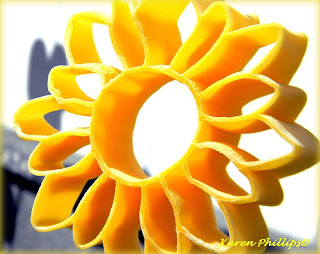Ciao Giuseppe! How are you? It was late afternoon when I arrived at the Chiostro di San Leone in Gragnano, a small town about a half hour from Naples. Giuseppe Di Martino had flown in from Germany on his way back from Vancouver and Washington D.C. just a couple of hours earlier, but his face didn't show that he had been up for the last 24 hours.
 |
| Giuseppe Di Martino |
Di Martino, owner of two pasta factories in Gragnano, is used to travelling the world talking about pasta and Gragnano. On this particular afternoon, he was programmed to be the guest speaker in a small corner room accompanied by a bag of wheat, a bag of grain, a bag of flour, and a bag of pasta. A small corner room with a soft gentle Gragnano breeze.
He began by discussing the history of pasta making in Italy in general, dating back to the Roman Empire.
He spoke about grano duro, durum wheat. Wheat grown in hot dry areas, some even sporting long black bristles...
He spoke of harvest periods, how they differed depending on the area where wheat is grown...starting from North Africa, Southern Italy, and then Northern Europe. How pasta made with this wheat was easier to asciugare, dry. And how it as the wheat used to make the first lasagne oh so many years ago.
He spoke of grano tenero, soft wheat, grown in the areas north of Rome. Where the climate is a tad bit more humid. So it is understandable that this wheat that produces pasta dough that is more elastic, perfect for making handmade pasta.
And then he spoke of the history Gragnano, his hometown and why it is the perfect place to produce pasta. They have been doing it industrially since the mid 16th century. But why here? There aren't any fields of grain. No, but there is Gragnano unique location surrounded by mountains three sides, with a passionate breeze, vento maestrale, coming in from the sea. Gragnano's Via Roma was designed back in the 1800s to take advantage of the sun, the wind, the air. Back then, nearly 100 different pasta makers would hang their pasta out to dry during the day. That was then, pasta production is now done inside, in modern facilities.This, along with fresh well water and their wealth of knowledge and experience have made Gragnano one of the most famous places for pasta today.
Di Martino wasn't through. He wanted to highlight a few things. Like how important which type of die is used tn pasta production. And on the table, next to the wheat, grain, flour and pasta he had a bronze die...
Many companies in Gragnano use this particular die because it gives their pasta a rough feel to it. Perfect for the many varieties of pasta sauces to cling on tight. Teflon coated dies, on the other hand, prouduce pasta with a smooth surface. Something to take note of the next time I read a package of pasta.
There were many things to take note of that good afternoon. How Di Martino feels about spaghetti with clams (linguine s better) and spaghetti bolognese ( a definite NO !!the sauce is just too heavy). The right cooking time for pasta, the right utensils when eating. He continued, sharing his passion and love for pasta with the 20 or so who decided to spend an hour of their afternoon with Di Martino that afternoon.
In a small corner room in Chiostro di San Leone...with a bag of wheat, a bag of grain, a bag of flour, a bag of pasta...
and a gentle Gragnano breeze...













No comments:
Post a Comment